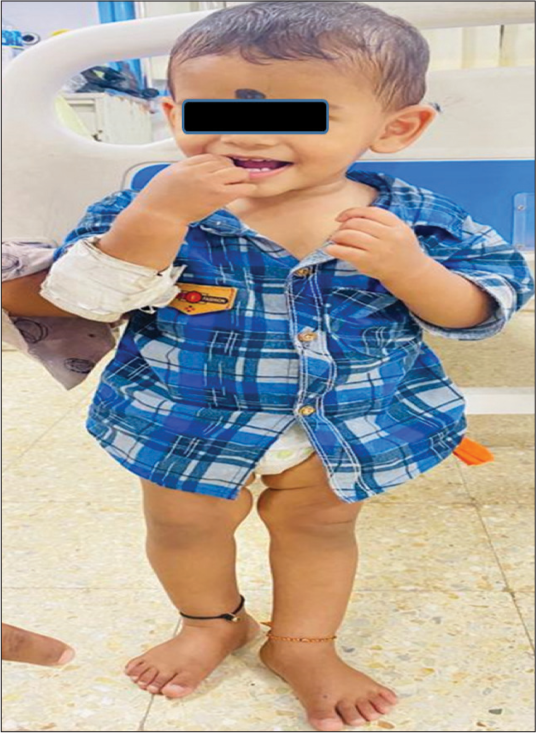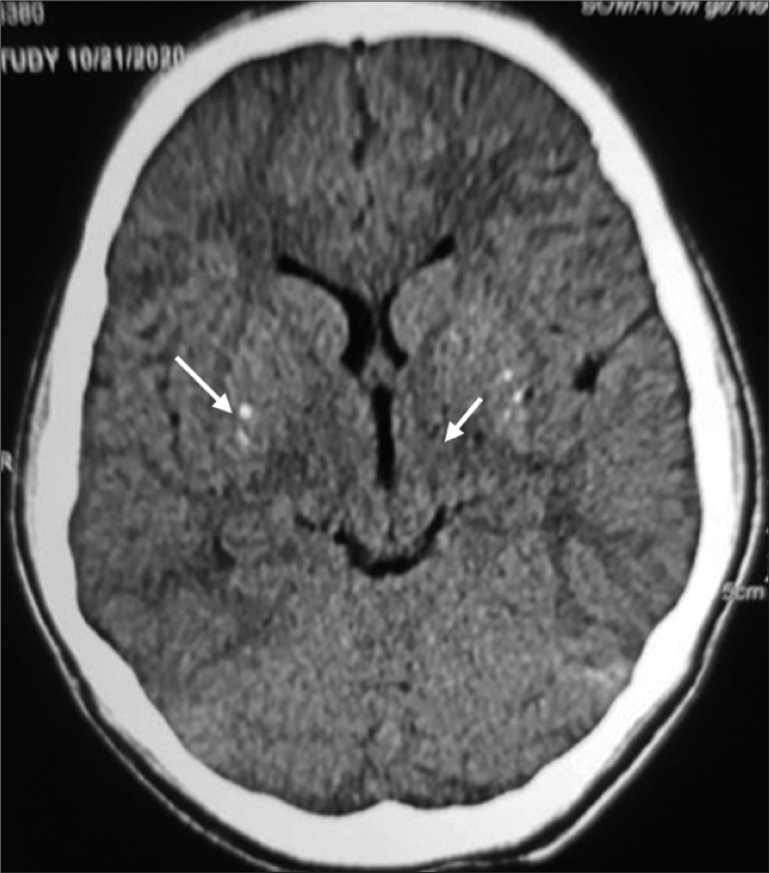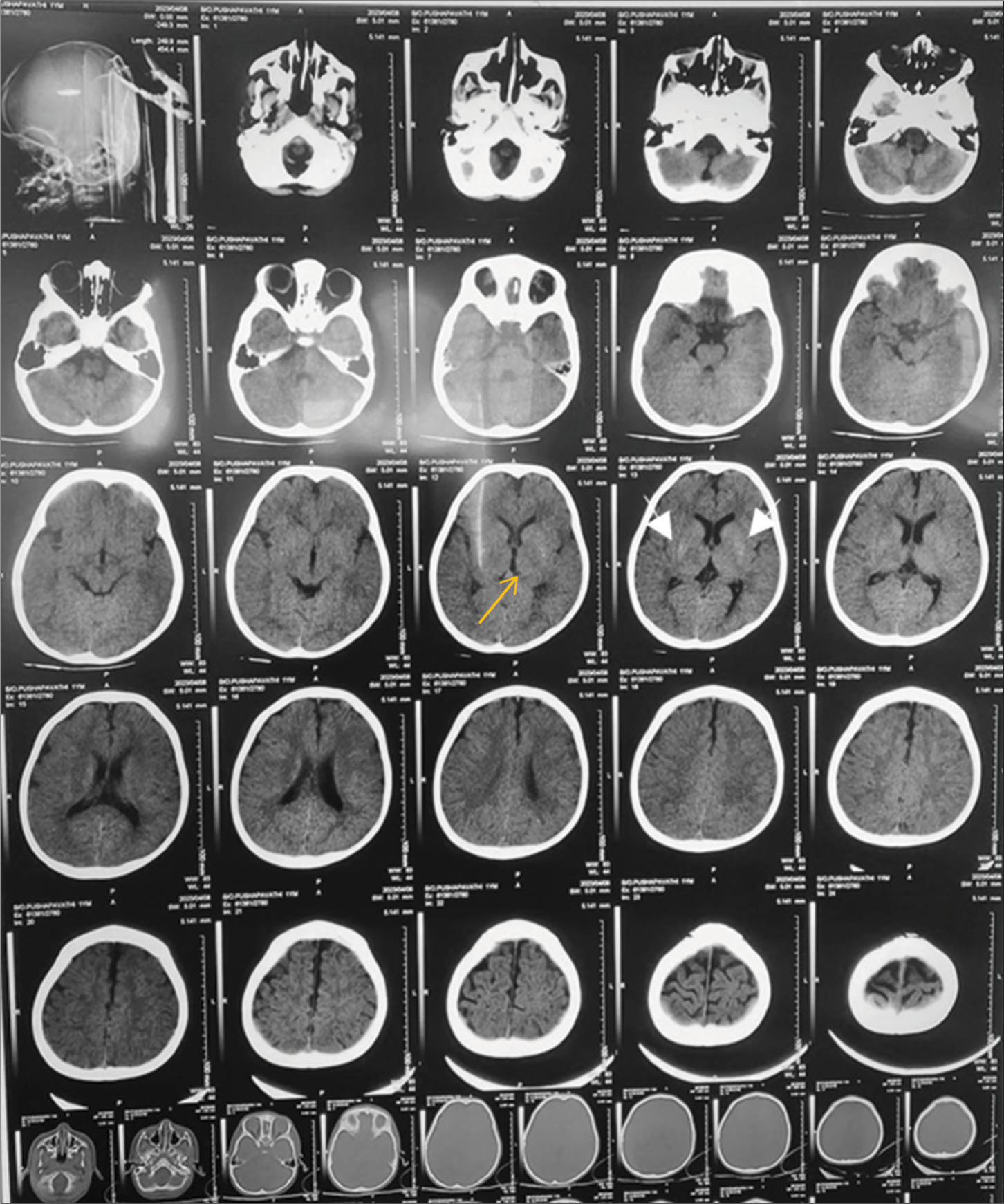Translate this page into:
Mineralizing angiopathy of lenticulo-striate arteries resulting in basal ganglia infarct – A rare case report
*Corresponding author: S. B. Udaykumar, Department of Pediatrics, Vijayanagar Institute of Medical Sciences, Ballari, Karnataka, India. dr.udaykumar.b@gmail.com
-
Received: ,
Accepted: ,
How to cite this article: Udaykumar SB, Priyanka S, Anwar M, Durgappa H. Mineralizing angiopathy of lenticulo-striate arteries resulting in basal ganglia infarct – A rare case report. Wadia J Women Child Health. 2024;3:83-6. doi: 10.25259/WJWCH_30_2024
Abstract
Arterial ischemic stroke following minor head trauma in young children is not an unknown entity. Here is an 18-month-old male child who presented with complaints of 3–4 episodes of convulsions in the form of uprolling of eyes and posturing of the left upper limb and lower limbs and sudden-onset of left-sided hemiparesis since 4 days following minor head trauma. The child was hemodynamically stable but there was hypertonia, power of <3/5 and brisk deep tendon reflexes in the left upper and lower limbs with normal findings in the opposite side. Cranial nerves, sensory and cerebellar systems were not involved. Computed tomography brain was done which showed mineralization of lenticulostriate arteries (MALS) and infarct in basal ganglia. The child was started on aspirin at 3 mg/kg/day along with physiotherapy and he showed significant improvement.
Keywords
Trivial trauma
Mineralization
Lenticulostriate arteries
Basal ganglia infarct
INTRODUCTION
Mineralizing angiopathy of lenticulo-striate arteries (MALS) following minor head trauma leading to basal ganglia infarct is a distinct clinical entity presenting in children commonly aged 6 months to 2 years with basal ganglia stroke often precipitated by minor head trauma. Incidence is <1% in infants and toddler as per Indian studies. They usually present with rapid-onset hemiparesis and transient hemidystonia. The exact cause of this entity is not known although multiple theories exist. Most believe that it is due to the excessive stretching of the arteries at the point of arterial tethering during minor trauma as the angle between middle cerebral artery and lenticulostriate arteries is believed to be acute during infancy. It is also thought to be due to the persistent form of fetal mineralization of lenticulostriate vessels. MALS following minor head trauma presenting as basal ganglia infarct is a clinicoradiological diagnosis and does not require unnecessary evaluation or extensive workup and has excellent prognosis if intervened early with aspirin which prevents recurrence of further episodes.
CASE REPORT
Eighteen-month-old male child, resident of Holagunda village in Ballari district of Karnataka, presented with complaints of 3–4 episodes of uprolling of eyes and abnormal movements involving the left upper limb and lower limbs followed by weakness of the same side of body preceeded by minor head trauma, 4 days ago without significant past medical history. He was born to nonconsanguineously married couple with a history of 4 spontaneous 1st trimester abortions previously. Mother had cerebrovascular accident 6 years ago which was not evaluated. The child was developmentally appropriate for the age. On examination, the child was hemodynamically stable, conscious, and oriented at the time of presentation with stable vitals and was able to stand with support [Figure 1]. On neurological examination, higher mental functions were normal, hypertonia in left upper and lower limbs with power of 3/5 and increased deep tendon reflexes. Routine blood investigations including coagulation profile were normal. Computed tomography (CT) brain was done which showed MALS and infarct in basal ganglia [Figures 2 and 3].

- Patient stands with support due to left hemiparesis.

- Computed tomography brain cut section showing linear calcifications in Basal ganglia (white arrows).

- Computed tomography brain showing calcification of lenticulostriate arteries (white arrows) and basal ganglia infarct (yellow arrow).
Aspirin in dose of 3 mg/kg/day once daily was given for 2 weeks, subsequently reduced to 1 mg/kg/dose. Supportive therapy and physiotherapy was also provided. The patient improved clinically over few days with improvement of weakness without any sequelae and at 2 years of follow up there was no recurrence of symptoms.
DISCUSSION
Jetha et al., have studied a case series of MALS and concluded that the condition presents as ischemic stroke involving basal ganglia following trivial trauma and seen good outcomes in all four cases.[1]
The pathogenesis of ischemic stroke after minor head injury in children is being explored. A proposed hypothesis during infancy is that mechanical forces cause rapid brain shift during trivial trauma, leading to excessive stretching of arteries, leading to disruption between the fixed intracerebral portion of the vessel and the extra cerebral mobile portion. This leads to the formation of thrombus, which is mainly attributed to shearing stress due to vasospasm, leading to intimal lesion in the vessel.[1]
A case series done by Baby et al., reported that thin sliced multiplanar reconstruction or spiral CT is the investigation of choice for MALS and it has a good prognosis or outcome.[1] Acute ischemic strokes involving basal ganglia after minor head trauma constitutes <2% of all childhood ischemic strokes.[2]
Basal ganglia stroke following trivial head trauma can recur after a latency of 18 months following initial insult.[3] The manifestation of acute recurrent transient dystonia in some individuals as the sole presenting symptom is unique to infarcts involving the basal ganglia complex. In unilateral stroke the outcomes are good, whereas infants with bilateral (recurrent) strokes had significant long-term disability.[4] Gowda and Nagarajan have stated in their recent publication that cause for MALS is unknown and is believed to be due to excessive stretching of the arteries at the point of arterial tethering when the angle between middle cerebral artery and lenticulostriate arteries are acute during infancy. It is also thought to be due to the persistent form of fetal mineralization of lenticulostriate vessels.[5] The abnormal movements involving the left side of the body can be transient dystonic movements due to the involvement of right lentiform nucleus and hemiparesis is due to the mineralization of lenticulostriate arteries which also supply to internal as well as external capsule in the brain apart from basal ganglia.
CONCLUSION
Patients with MALS have excellent prognosis if identified and treated early. CT brain plain with thin splicing or multiplex spiral CT will confirm the diagnosis, does not need much evaluation or extensive workup, and improve with supportive as well as appropriate treatment with antiplatelet drugs such as aspirin and physiotherapy. The exact cause of MALS is still unknown and needs further research in that regard.
Ethical approval
Institutional Review Board approval is not required.
Declaration of patient consent
The authors certify that they have obtained all appropriate patient consent.
Conflicts of interest
There are no conflicts of interest.
Use of artificial intelligence (AI)-assisted technology for manuscript preparation
The authors confirm that there was no use of artificial intelligence (AI)-assisted technology for assisting in the writing or editing of the manuscript and no images were manipulated using AI.
Financial support and sponsorship
Nil.
References
- Mineralising angiopathy of lenticulostriate vessels in childhood: Series of four cases. J Clin Diagn Res. 2021;15:SR01-2.
- [CrossRef] [Google Scholar]
- Mineralizing Angiopathy of Lenticulo-striate Arteries with infantile basal ganglia infarct following minor head trauma: A case series. Ann Indian Acad Neurol. 2019;22:316-9.
- [CrossRef] [PubMed] [Google Scholar]
- Mineralizing angiopathy presenting with recurrence of basal ganglia stroke following minor head trauma. J Postgrad Med. 2019;65:116-8.
- [CrossRef] [PubMed] [Google Scholar]
- Mineralizing angiopathy with infantile basal ganglia stroke after minor trauma. Dev Med Child Neurol. 2014;56:78-84.
- [CrossRef] [PubMed] [Google Scholar]






